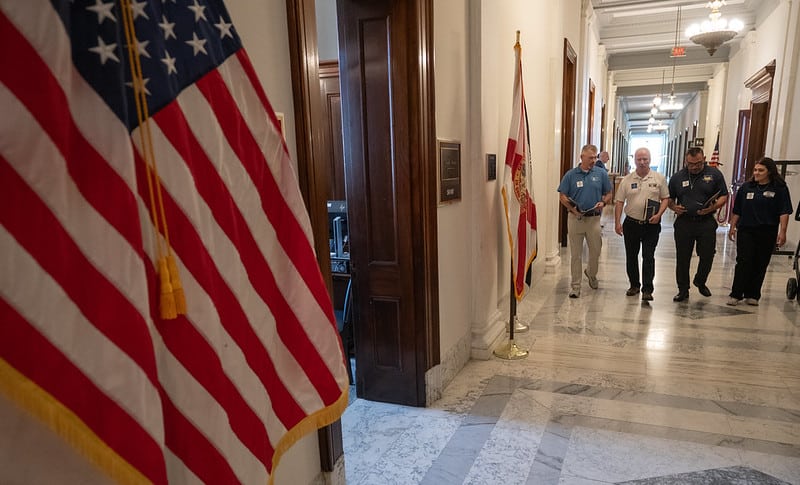
Surviving Record Heat
The heat index recently soared to 111 degrees in Houston, Texas, but the real-feel temperature climbed even higher than that inside the heavy personal protective equipment (PPE) that John Hayes and his colleagues at Ecoservices wear on the job.
Sweat poured from the workers—clad in full-body hazardous materials suits, heavy gloves, splash hoods and steel-toed boots—as they sampled and processed chemicals from huge metal containers under a searing sun.
Fortunately, as members of the United Steelworkers (USW), these workers negotiated a policy requiring the chemical treatment company to provide shade, cool-down periods and other measures to protect them during sweltering days.
But unless all Americans have common-sense safeguards like these, workers across the country will continue to get sick and die during ever-worsening heat waves.
The USW, other unions and advocacy groups are calling on the U.S. Occupational Safety and Health Administration (OSHA) to speedily enact a national standard specifying the minimum steps all employers need to take to safeguard workers from unprecedented and deadly bouts of heat.
Because of union advocacy, OSHA already has national standards that protect workers from falls, trench collapses, asbestos exposure, infectious diseases, injuries from equipment and many other workplace hazards. It’s way past time to also protect workers from the heat waves that are growing more severe, lasting longer and claiming more lives each year.
“Heat affects everybody. It doesn’t care about age,” observed Hayes, president of USW Local 227’s Ecoservices unit, who helped to negotiate the heat-related protections for about 70 workers in treatment services, maintenance, logistics and other departments.
“There’s so many things they can come up with,” he said of OSHA officials.
The policy the union negotiated with Ecoservices requires low-cost, sensible measures like water, electrolytes, modified work schedules, tents and fans, and the authority to stop work when conditions become unhealthy and unsafe.
“If you start to feel dizzy or lightheaded, take your timeout,” Hayes reminds co-workers. “Don’t worry about it.”
Two years ago, OSHA initiated efforts “to consider a heat-specific workplace rule.” In the meantime, states and local governments are free to make their own rules, let workers fend for themselves or even put workers at greater risk.
While workers everywhere would benefit from a national heat standard, nowhere is the need more obvious than in Texas.
It’s one of the states hardest hit by the heat wave now blistering much of the country, with cities like Junction and Laredo shattering heat records.
Worse, in the midst of the crisis, right-wing Gov. Greg Abbott signed a new law sweeping aside city and county ordinances mandating water breaks for construction workers. The so-called “Death Star law” is nothing but blatant pandering to Abbot’s corporate cronies at the expense of workers’ lives.
The law goes into effect Sept. 1. But in the three weeks since Abbott signed it, at least three workers died in the face of scorching conditions.
One was a letter carrier, another a utility lineman who traveled from West Virginia to Texas to restore power knocked out by the heat, and the third an otherwise healthy construction worker who collapsed while helping to meet Houston’s long-running building boom.
“We were called essential workers,” Hayes said, referring to Texans who remained at their jobs during the COVID-19 pandemic to serve residents and keep the state operating. “Now some of us can’t even get a drink of water.”
Heat already ranks among the top causes of occupational incidents and death, according to Public Citizen’s analysis of data from the U.S. Bureau of Labor Statistics and other sources.
Heat can directly sicken or kill, as it did the Texas construction worker. But it also induces fatigue, dizziness and cognitive impairments leading to falls and other incidents on the job.
And with climate change fueling heat waves, workers face ever-greater risks.
While workers in the construction, agriculture and other outdoor industries battle the sun, those working indoors face their own challenges from summer heat that’s magnified by steel beams, metal pipes and energy-generating equipment.
“First of all, we’ve got huge furnaces that are melting down scrap aluminum to cast ingots,” explained David “Buzz” Sawyer, president of USW Local 309, which represents about 840 workers at two Arconic plants in Alcoa, Tenn.
“It goes into the furnace, and from that point on, it’s either molten or relatively close to molten,” continued Sawyer, noting that welding jobs, a rolling mill and other processes also expose workers to heat as they manufacture material for road signs, cars and other products.
Like workers at Ecoservices, Local 309 members negotiated a contract with numerous protections, including the authority to stop work, in dangerous temperatures. “We’re the ones doing the work and know what a safer job looks like,” observed Sawyer.
Worker solidarity fuels the robust safety system. But a healthy, stable work force is also in the company’s best interest, he said, noting the national heat standard is needed because some employers, as well as state officials like Abbott, lack both compassion and reason.
“How in the world can you deny your workers an opportunity to get a drink of water?” he said. “If you’re going to do that, what else are you going to do?”
Sawyer wants others to know about the strong safety measures that union members built at Arconic and to think, “We deserve it, too.”
At the end of a shift, he noted, “This is what takes you home to your family.”
By clicking Sign Up you're confirming that you agree with our Terms and Conditions.
Related Blogs
Ready to make a difference?
Are you and your coworkers ready to negotiate together for bigger paychecks, stronger benefits and better lives?

